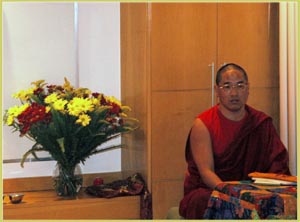“There is nothing in particular special about me other than this: I was able to meet a Vidyadhara Lineage holder, His Holiness Dilgo Khyentse Rinpoche when I was fifteen. I have also been able to meet many other great Nyingma Lamas with immeasurable qualities.
Ever since I was very young I have wanted to realize and preserve the vast meaning of my teacher and Lord Buddha’s teachings. I have been fortunate enough to find the nectar of Dharma, which I continue to practice and my aspiration now is to share this happiness with others.”
A lama is a teacher. To take the title of Lama means you have truly learned the Dharma. According to A Cascading Waterfall of Nectar:
“No matter what, the general tradition of the Mayahana, the mind of the Lama being relied on must be permeated with the bodhicitta. In the new and old traditions of the Mantrayana, there are many teachings on the various individual qualifications of a Lama. In brief,
A Lama who teaches Tantra, gives transmissions, and teaches upadesha must have the treasure of the tantras, transmissions, and upadesha of the tradition of the Great Perfection, must have perfected the four rivers of the descent of the lineage of actual speech in the Nyingma Vajrayana lineage, and must have the capacity to accomplish and fulfill the wishes of disciples.
A Lama must especially be skilled in the meaning of the tantras of Vajrayana and in how to accomplish the four activities, and must fully contain the meaning of the developing and completion stages and upadesha, and have the signs of accomplishment of confidence. As it says in The Stages of Magical Manifestation: One needs to find and rely on a Vajra Master who has the eight natural qualities.”
Once a sign arises, the Lama can request his lineage holders permission to teach disciples, but not until he has recieved the lineage holders permission is he truly a teacher. After permission is recieved, everyone is now in agreement with this endeavor. To be a Lama means to have a warm heart. The word Lama means “Great Mother.” Inherent in this meaning is great responsibility to guide undecievingly.
A Lama needs to engage in good action with pure intention. A disciple should look for the Lama’s credentials, asking “Does this Lama have pure lineage and does this Lama hold pure Samaya?” Also, does the Lama take retreat, and what is the Lama’s practice like? A disciple will resemble their teacher and that teacher’s teacher, and so on. Otherwise,
if you are not following an authentic lineage holder, a truly qaulified teacher, you are only following your own ideas and could go the wrong way. For example, the teacher can give the direction toward enlightenment, and say, “Go East!.” while the disciple ends up going West.
To respect the Dharma and the Teachings is the most important requirement to giving birth to true realization. Lack of respect is the obstacle to the propagation of Dharma. In otherwords, if you do not respect the teachings or the teacher you will never the recieve any blessings or benefits of the path. This is because the door to your heart is closed, nothing pure can enter.
According to Lopon Osel: “In my experience some students thinking is so negative they come to feel the mistakes and obscurations lie within the teacher and teachings instead of themselves. To those who feel this way my best advice is to examine carefully and see what good qualities are there.
Otherwise the potential for improvement is blocked and the student will not be able to improve their pure intention, or view pure phenomena with pure perception. Instead they will move from wrong to wrong going further down into samsara. What a waste of a wonderful opportunity.”
Our goal with this shedra is to establish all who have the inclination towards this teaching on the upward path and we must stress that the most vital factor in realizing Dharma is holding the teaching as well as the teacher with utmost respect.
If you wish to read more about Lopon Osel,
visit welcomingbuddhist.org

